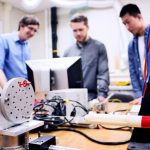 I’ve written a few times previously about various VR/AR platforms that aim to allow medical professionals to simulate their work and therefore practice in a safe, yet realistic environment. For many areas of medicine however, being hands on is hard to beat, and this is certainly the case with the administration of needle-based procedures such as epidurals.
I’ve written a few times previously about various VR/AR platforms that aim to allow medical professionals to simulate their work and therefore practice in a safe, yet realistic environment. For many areas of medicine however, being hands on is hard to beat, and this is certainly the case with the administration of needle-based procedures such as epidurals.
Researchers from Penn State have developed a cheap needle-insertion simulator that they believe can help improve the technique and dexterity of staff. The team believe that existing methods are often too expensive and fail to adequately prepare doctors for the various situations they may encounter.
The hand-held device simulates the tactic feeling of the instrument as it passes through multiple layers of tissue. It’s capable of providing digital feedback on each user’s performance so that their ability to produce a steady rate of insertion can be tested. This can be especially challenging, even for experienced doctors.
“There’s a buildup of force upon tissue deflection and a sudden release of force upon tissue puncture,” the researchers say. “This training tool can help surgeons, residents, and med students improve their dexterous abilities.”
Smart training
The team believe the device will provide users with real-time feedback as they train so that adjustments can be made efficiently and effectively. They hope it will significantly improve existing methods that largely rely on observation.
Using mannequins is a poor substitute for real tests as they are not only expensive, but often fail to adequately replicate the range of body types a doctor will encounter during a typical day. The new device is capable of accurately simulating a range of scenarios, including different skin thickness and body weight.
“Being unprepared for diverse patient scenarios can increase the probability of complications occurring, and this training will help the doctor’s ability to adapt,” the team explain.
They eventually hope that the tool will be used in the training of doctors in wider range of specialities, including radiology and emergency medicine, not least because of it’s relatively low cost.
“We’re really excited because the device is slated be relatively low cost, less than $100,” they explain. “I would love to see this widely applied, all the way down to undergraduate pre-med programs. It could be impactful to easily assess this skill and provide meaningful feedback to allow for continuous improvement.”